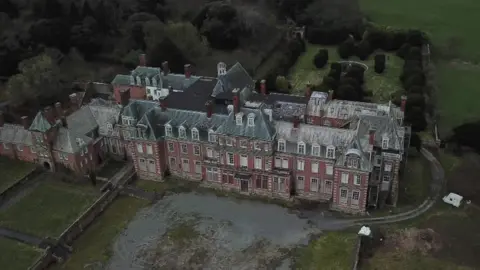Kinmel Hall: Action needed to save site say campaigners
The future of a north Wales mansion, dubbed the Welsh Versailles, is at risk if more is not done to preserve it, campaigners have warned.
Kinmel Hall, near Abergele, Conwy, was built in the 1870s, and is believed to be Wales' largest country home.
The Friends of Kinmel Hall said enforcement was needed to stop the now-empty building becoming derelict.
Conwy council said owner, Acer Properties Ltd BVI's, has pledged to spend money on the repairs.
The council said the pledge made by Acer Properties, which has owned the Grade I listed hall for the past 10 years, means it did not think enforcement action was needed at this time.
The French chateau-style building has not been occupied since the turn of the century.
 William Jonkler
William JonklerTim Vince, of The Friends of Kinmel Hall, said: "Any building that is left effectively unoccupied for 20 years without any life within, without any heating, will deteriorate.
"There has been vandalism. Some of the lead has been taken from the roof, some of the treasures have been taken from within. It's a very sad story."
Kinmel Hall was built by the Hughes family, whose wealth was generated from copper mining on Anglesey.
They only occupied the house, which also boasted a stunning garden designed by the same designer who laid out London's Regent's Park, for a couple of generations.
The building was then leased out and used for a variety of different purposes through much of the 20th Century and was home to Clarendon Girls' School for about 30 years.
That ended when a fire swept through much of Kinmel Hall in 1975.

Mr Vince's father Eddie stepped in, spending £2m of his own money in the 1980s helping to restore the site with the help of public money.
"He made a great commitment to the hall and there were many volunteers from the local area who helped with the restoration," said Mr Vince.
"It also received about £500,000 from the Historic Buildings Council of Wales, which became CADW, so there's quite a stake from Wales into this wonderful building."
Having risen from the ashes, The Friends of Kinmel Hall argue a detailed plan of action is now needed if it is not going to fall into a permanent state of decline and disrepair.
The group estimates about £1m needs to be spent just to make the building secure and it may take £30m to restore it to the point where it can have a use that helps meet the ongoing maintenance costs.
The Friends of Kinmel Hall said some public money would probably be needed as part of a partnership approach involving the current owners, the council, support groups and national government to safeguard its future.
It has not been possible to contact Acer Properties, which is registered in the British Virgin Islands, but the council has the role of enforcing rules aimed at protecting listed buildings.

It said: "We are in regular discussions with the owners and they are in the process of making arrangements to carry out repairs.
"At the moment, the owners are taking positive steps and are in the process of making arrangements to carry out repairs to the property and although the matter is under review we do not consider that enforcement action is necessary at this present time. "
The condition of Kinmel Hall has attracted the attention of a range of conservation experts who also believe action is needed to save the site.
Among them is Peter Hare who has worked on a number of conservation and restoration projects, including Windsor Castle following the fire there in 1994.
"It's now listed as one of the 10 most at-risk Victorian buildings in the the UK," he said.
"The price of fixing it is constantly going up. The longer it's left, the more the fabric is being destroyed and the less we've really got left of it. And it's awful."

- STAND UP IN MY HOUSE: Elis James hosts some of the finest comedians from across Wales
- ANOTHER ICE AGE?: Adam Walton explores past ice ages and asks if we might see more in the future

